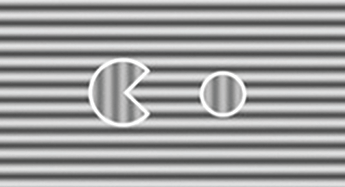
What’s the most common treatment for amblyopia? Patching the stronger eye, forcing the weaker eye to do all the work. Is this really the best way of doing things? Perhaps not. Teng Leng Ooi, Professor of Optometry at The Ohio State University, calls this a “push-only” method of treating amblyopia, because the dominant eye remains completely unused. He’s developed what he calls a “push-pull” method that makes both eyes work together, but still exposes the weaker eye to a more complex set of images that generate stronger stimuli of that eye’s visual system. By forcing both eyes to cooperate (but suppressing the dominant eye’s power), he and his group target important pathways in the brain that must be active to produce balanced vision. Their method taps into the neural networks responsible for both inhibition and excitation signals governing binocular vision. “We know push-pull works,” he says. “Now it’s a question of how much better we can make it work.”
The genius part of Ooi’s method is that his push-pull training comes in the form of a computer game (Figure 1). The games feature groups of lines in different orientations; players wear red-green 3D glasses that filter images so that the dominant eye sees only a background full of horizontal lines, but the weaker eye sees bordered disks with vertical, horizontal or diagonal lines imposed upon that background. “We make sure the weak eye is seeing the contrasting images at all times,” says Ooi. “The strong eye has stimulation, but it is cortically suppressed. That is the ‘pull’. The weak eye is ‘pushed’ to work.”
One of the games is a “cat and mouse” challenge where players direct their Pac-Man-shaped “cat” to eat scurrying disk “mice” with lines that are oriented in the same direction as the cat’s. Another shows a matrix of disks with lines in different orientations; players use cursors to line up a “master disk” to match the orientations of the lines. “In tests of these games, we’ve seen improvements in depth perception and binocular vision in people with amblyopia,” Ooi says. “The more abnormal the binocular vision is, the higher the number of training sessions needed.” It works in adults too – pilot testing on two grown-ups has demonstrated improvements in their weak-eye vision from 20/63 to 20/50 in one and from 20/25 to 20/20 in the other. The games add an important element to amblyopia treatment: fun. In contrast with earlier training designs, where participants had to keep their eyes still and look at the same target for as much as an hour and a half, these games only require a few minutes of concentration at a time – and as patients’ playing skills improve, researchers can make the tasks more complicated or impose shorter deadlines to keep them invested in the challenge. Although in the long run patients may need to spend a long time training their eyes, games like these keep them engaged for longer, ultimately to the benefit of their vision.
